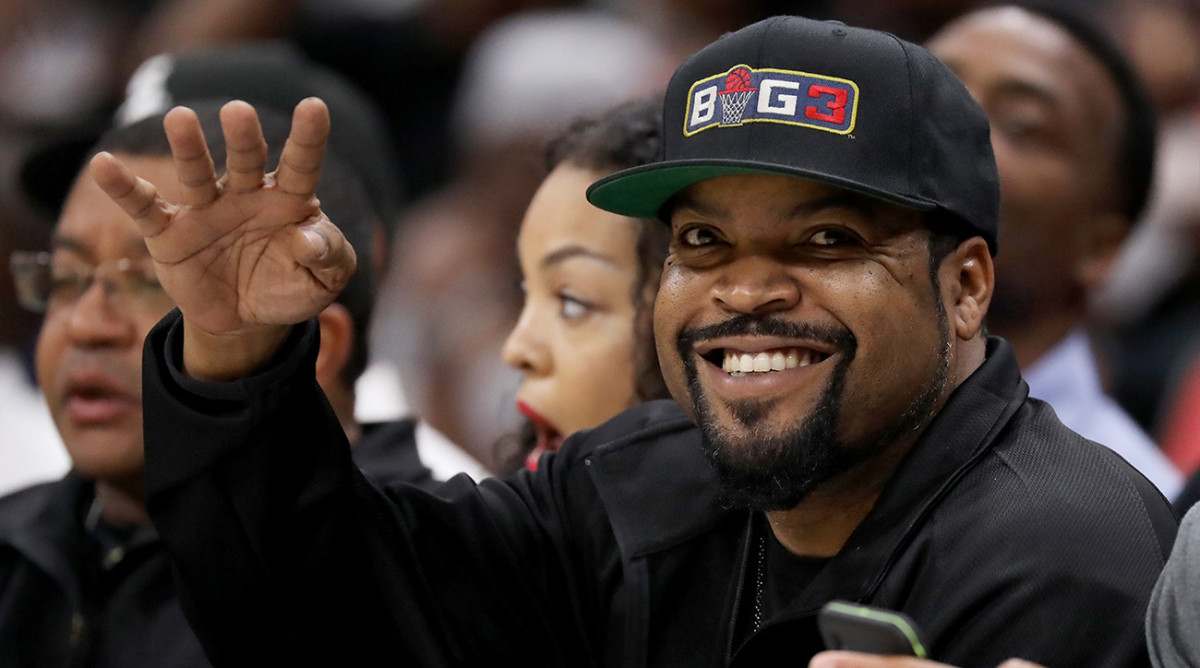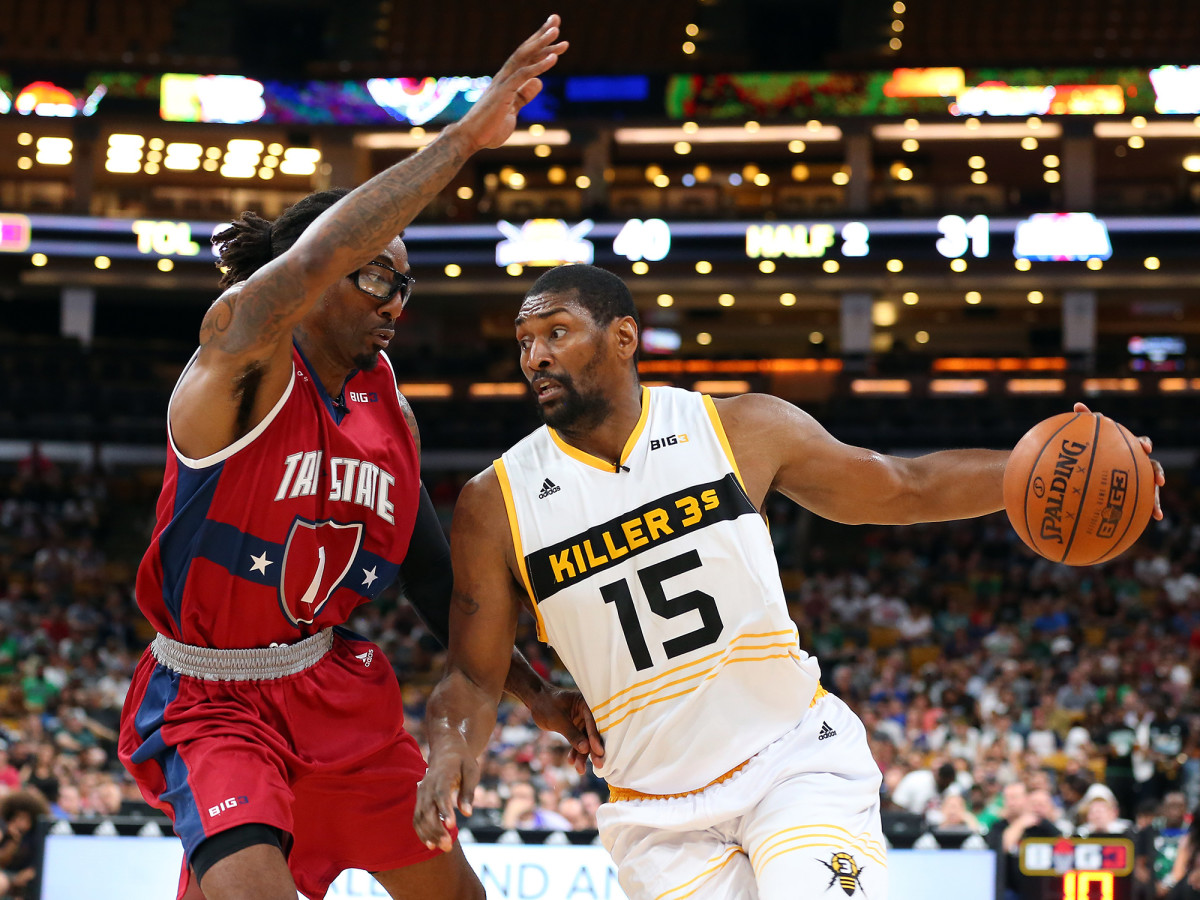An NBA Offseason Role Realized, the BIG3 Now Has Grander Ambitions

The discussion began, as so many do, with Kobe Bryant. The Lakers legend had just finished dismantling the Jazz in the final game of his illustrious 20-year career, hitting clutch shot after clutch shot. Two thousand miles away, diehard Lakers fan Ice Cube was on a movie set in Atlanta, watching the performance with bittersweet reverence. He’d been toying with the idea of starting a basketball league of his own, but had yet to put it into action.
“It kind of lay dormant in my head until Kobe scores these 60 points,” Cube said. “And then I realized there’s nowhere to see him play again. So I started thinking, there should be a place to see these guys, because I know they still play.” He called his manager and business partner, Jeff Kwatinetz, and began molding what would become the BIG3, a professional three-on-three league featuring former NBA players with something still left in the tank.
Now midway through its second season, the BIG3 is carving out a role as a place where players and fans can get their basketball fix when the NBA is no longer an option. For retired stars, it offers an alternative to toiling away overseas or calling it quits altogether. For fans, it’s a dose of nostalgia to help power them through the long summer months of the NBA offseason.
The likes of Carlos Boozer, Chris “Birdman” Andersen, Baron Davis, and Metta World Peace are among the 49 former NBA players currently on BIG3 rosters, while coaches include Hall of Famers Julius Erving, George Gervin, Gary Payton, and Nancy Lieberman. Bryant still has an open invitation to join, per Cube, and some players and executives have mentioned Vince Carter and Jamal Crawford as possible additions after they retire from the NBA.
Games air on Friday nights on Facebook Live and FOX or FS1, and drew an average ticketed audience of over 14,000 through the first five weeks of the season (up from roughly 11,500 last season). The BIG3 targets a younger audience than the NBA, NFL, and MLB, and league brass is bullish on the possibility of three-on-three basketball becoming a more popular form of the game. The NCAA held a three-on-three tournament this year during Final Four weekend, and the sport will be added to the Olympics in 2020. “Our sport is more diverse, younger, more inclusive,” said Jeff Kwatinetz, Ice Cube’s longtime business partner and BIG3 co-founder. “It’s faster, it’s quicker. It just fits what the younger generation wants.”

The league’s eight-game, rotating-venue schedule helps drive interest and promotes a quality product on the court, while a performance-based revenue sharing system incentivizes teams to hustle every week. Every game has stakes, and having six days off between games allows players to give maximum effort every game and take more time to recover afterward. With only six players on the court and nowhere for weak links to hide, players have little choice but to compete hard, lest they be exposed. Specialists and one-way players don’t have quite as much utility in a three-on-three setting as they do on five-man units, and the open real estate created by the absence of those two extra players lends itself to a spaced out style.
“There’s slight room for error,” said Nate Robinson, who plays for Tri-State. “You can’t help like you want to in five-on-five. It makes the court bigger and you’ve got to kind of hold your own. It’s more open, and you’ve just got to be able to make shots.”
Games are physical, and menacing defenders like World Peace and Reggie Evans still punish opponents. Hand checks are allowed, both to encourage physical defense and accommodate players whose lateral quickness may not be what it once was. A 14-second shot clock helps keep the pace of play lively, while the four-point spots are an innovative wild card. This season, the BIG3 added a third referee, something players say has improved the physicality and flow of games without hindering the physicality and personality of the players. Occasionally, that intensity and boldness has boiled over and resulted in moments like Metta World Peace punting the ball into the stands and a tussle between Robinson and Rashad McCants earlier in the year.
For NBA Insiders, the NCAA Rule Changes Arrive with Confusion and Skepticism
For the time being, the BIG3 is fine serving as a complement to the NBA as it takes the small steps toward larger relevance. In the long term, however, they have much higher aspirations. “In 10 years I expect it to be the biggest league in America,” Kwatinetz said. “The biggest ratings, the biggest attendance. The thing that we have: demographics favor us. This is a sports that millennials play. It is the most accessible and most played sport in the world. So why wouldn't the most played sport in the world be the most viewed sport or two in the world?”
But, as the BIG3 has discovered, growing a young league can be a slow process fraught with obstacles and constraints. In the first season, there was naturally some skepticism regarding its legitimacy and staying power, and it isn’t yet a major part of the broader, mainstream sports conversation. Though the league’s talent pool is solid, it currently lacks the kind of elite top-end star power that it might need to break into that conversation. The BIG3 will trail the NBA in both quality and popularity for at least the foreseeable future, and between the NBA offseason news cycle and growing popularity of the WNBA, vying for relevance in the summer has proven challenging. Next season, the league plans on expanding its programming schedule to enhance understanding of the game and hold interest outside of Friday nights.

The inaugural season also presented an unusual set of PR challenges. Several notable players have missed significant time due to injury, including Allen Iverson, whose BIG3 career flamed out in 2017 out with two missed games and a suspension. Roger Mason Jr., the league’s original commissioner, was fired in 2017 for alleged corruption and ties to Qatari investors who attempted to scam the league out of millions of dollars. Mason also alleged that the league had operated in a “hostile and racist” environment. (Clyde Drexler has since taken over as commissioner.)
“The BIG3 will not allow anyone to harm our league, our players and our coaches,” Kwatinetz wrote in an open letter in June. “When confronted with attempts by ‘investors’ claiming to act on behalf of Qatar to harm the league and use it to fulfill their own agendas, our players and coaches stood shoulder to shoulder in resistance with BIG3 and conducted themselves admirably and with integrity. That’s what makes BIG3 great.”
The league and its players have developed a mutual respect and built up equity with one another that allows a two-way conversation to shape the league’s direction. The two sides collaborate, and the league is intentional about empowering the players rather than creating divisions between athletes and executives. Team captains effectively double as GMs, and there are no individual owners of teams. “We are not trying to build the league on the backs of players, we’re building it with our players,” said Amy Trask, who was named Chairwoman of the Board after serving as the league’s CEO in 2017. “Every person involved in a league has an interest in its success. Why wouldn’t we work with our players and coaches in an effort to achieve success?”
Andre Iguodala Q&A: The Talent of Kevin Durant, Generosity of LeBron and Allure of Golf
“It’s pretty cool that we have an input,” Robinson said. “It feels good that Cube and the players can talk as one and move as a unit towards our objective in trying to figure out how to make this league better and better in years to come.”
It’s that cooperation—and the result it produces on the court—that the BIG3 feels will win out in the long run. If the players feel a genuine enthusiasm for playing the game, the thinking goes, fans will reciprocate. “We don’t want to look like we’re looking at a product. We want to look like we’re looking at a game and we’re having fun, and that’s what the BIG3 promotes,” Ice Cube said. “And the guys have been playing great basketball. That’s what’s amazing, is at the end of the day the basketball is top-notch, fun to watch, and you can’t beat it.”
Kwatinetz cites the accessibility and ubiquity of the sport as a driver of interest around the globe, and the casual, intimate style of 3-on-3, he says, is something to which fans everywhere can relate. BIG3 games are already broadcast in roughly four dozen countries, and the league has designs of adding teams, lengthening the schedule, and expanding its presence to other countries, including Brazil and China.
Part of its long-term vision includes hosting an annual tournament featuring the best 3-on-3 teams from around the world. The league is in the first of a three-year deal with adidas, and executives have spoken with EA and 2K Sports about developing a BIG3 video game sometime in the future.
Even with sky-high ambitions, expectations must be appropriately tempered. But Ice Cube and Kwatinetz believe in what they’re creating, and feel it’s only a matter of time before fans do too. “We understand sometimes we’re ahead of the curve and it takes time for people to catch up,” Ice Cube said. “We don’t mind that, and we’ll wait for them to catch up. But we believe they will.”
